Report on Customer Perceived Value and Value Proposition for Puma
VerifiedAdded on 2020/06/03
|20
|5470
|31
Report
AI Summary
This report provides a comprehensive analysis of Puma's customer perceived value, utilizing marketing management principles and frameworks. It begins with an introduction to marketing management and the concept of customer perceived value, defining its components of benefits and sacrifices in the context of Puma's brand. The report then explores suitable models, including Monroe and Holbrook's typology of value, to identify customer perceptions. A comparison and contrast of Puma's value proposition with a rival firm, Adidas, is conducted to highlight areas for improvement. Benchmarking and value proposition strategies are discussed, leading to the proposal of a new value proposition for Puma. The report concludes with a summary of findings and recommendations, supported by references to relevant literature.

MARKETING
MANAGEMENT
MANAGEMENT
Paraphrase This Document
Need a fresh take? Get an instant paraphrase of this document with our AI Paraphraser
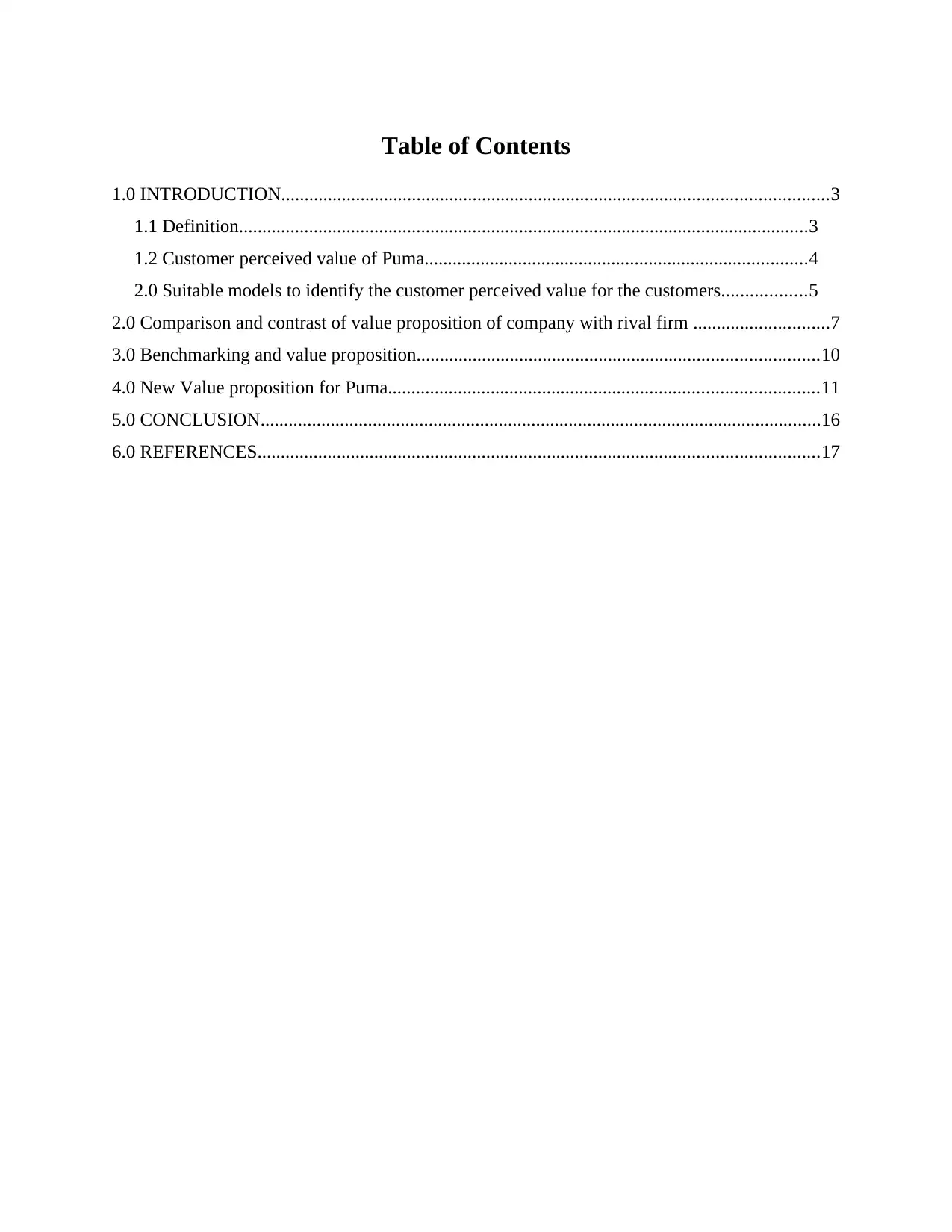
Table of Contents
1.0 INTRODUCTION.....................................................................................................................3
1.1 Definition..........................................................................................................................3
1.2 Customer perceived value of Puma..................................................................................4
2.0 Suitable models to identify the customer perceived value for the customers..................5
2.0 Comparison and contrast of value proposition of company with rival firm .............................7
3.0 Benchmarking and value proposition......................................................................................10
4.0 New Value proposition for Puma............................................................................................11
5.0 CONCLUSION........................................................................................................................16
6.0 REFERENCES........................................................................................................................17
1.0 INTRODUCTION.....................................................................................................................3
1.1 Definition..........................................................................................................................3
1.2 Customer perceived value of Puma..................................................................................4
2.0 Suitable models to identify the customer perceived value for the customers..................5
2.0 Comparison and contrast of value proposition of company with rival firm .............................7
3.0 Benchmarking and value proposition......................................................................................10
4.0 New Value proposition for Puma............................................................................................11
5.0 CONCLUSION........................................................................................................................16
6.0 REFERENCES........................................................................................................................17

⊘ This is a preview!⊘
Do you want full access?
Subscribe today to unlock all pages.

Trusted by 1+ million students worldwide
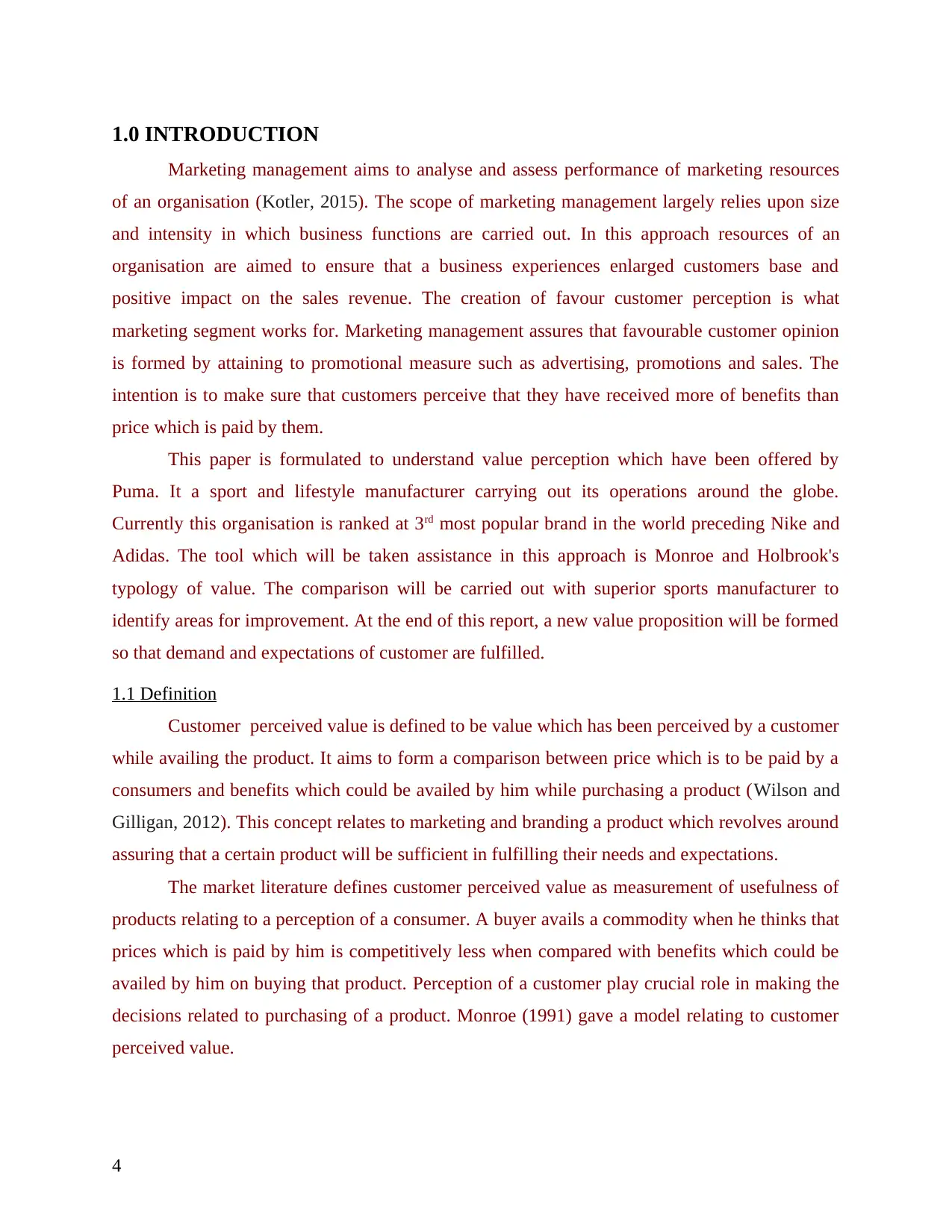
1.0 INTRODUCTION
Marketing management aims to analyse and assess performance of marketing resources
of an organisation (Kotler, 2015). The scope of marketing management largely relies upon size
and intensity in which business functions are carried out. In this approach resources of an
organisation are aimed to ensure that a business experiences enlarged customers base and
positive impact on the sales revenue. The creation of favour customer perception is what
marketing segment works for. Marketing management assures that favourable customer opinion
is formed by attaining to promotional measure such as advertising, promotions and sales. The
intention is to make sure that customers perceive that they have received more of benefits than
price which is paid by them.
This paper is formulated to understand value perception which have been offered by
Puma. It a sport and lifestyle manufacturer carrying out its operations around the globe.
Currently this organisation is ranked at 3rd most popular brand in the world preceding Nike and
Adidas. The tool which will be taken assistance in this approach is Monroe and Holbrook's
typology of value. The comparison will be carried out with superior sports manufacturer to
identify areas for improvement. At the end of this report, a new value proposition will be formed
so that demand and expectations of customer are fulfilled.
1.1 Definition
Customer perceived value is defined to be value which has been perceived by a customer
while availing the product. It aims to form a comparison between price which is to be paid by a
consumers and benefits which could be availed by him while purchasing a product (Wilson and
Gilligan, 2012). This concept relates to marketing and branding a product which revolves around
assuring that a certain product will be sufficient in fulfilling their needs and expectations.
The market literature defines customer perceived value as measurement of usefulness of
products relating to a perception of a consumer. A buyer avails a commodity when he thinks that
prices which is paid by him is competitively less when compared with benefits which could be
availed by him on buying that product. Perception of a customer play crucial role in making the
decisions related to purchasing of a product. Monroe (1991) gave a model relating to customer
perceived value.
4
Marketing management aims to analyse and assess performance of marketing resources
of an organisation (Kotler, 2015). The scope of marketing management largely relies upon size
and intensity in which business functions are carried out. In this approach resources of an
organisation are aimed to ensure that a business experiences enlarged customers base and
positive impact on the sales revenue. The creation of favour customer perception is what
marketing segment works for. Marketing management assures that favourable customer opinion
is formed by attaining to promotional measure such as advertising, promotions and sales. The
intention is to make sure that customers perceive that they have received more of benefits than
price which is paid by them.
This paper is formulated to understand value perception which have been offered by
Puma. It a sport and lifestyle manufacturer carrying out its operations around the globe.
Currently this organisation is ranked at 3rd most popular brand in the world preceding Nike and
Adidas. The tool which will be taken assistance in this approach is Monroe and Holbrook's
typology of value. The comparison will be carried out with superior sports manufacturer to
identify areas for improvement. At the end of this report, a new value proposition will be formed
so that demand and expectations of customer are fulfilled.
1.1 Definition
Customer perceived value is defined to be value which has been perceived by a customer
while availing the product. It aims to form a comparison between price which is to be paid by a
consumers and benefits which could be availed by him while purchasing a product (Wilson and
Gilligan, 2012). This concept relates to marketing and branding a product which revolves around
assuring that a certain product will be sufficient in fulfilling their needs and expectations.
The market literature defines customer perceived value as measurement of usefulness of
products relating to a perception of a consumer. A buyer avails a commodity when he thinks that
prices which is paid by him is competitively less when compared with benefits which could be
availed by him on buying that product. Perception of a customer play crucial role in making the
decisions related to purchasing of a product. Monroe (1991) gave a model relating to customer
perceived value.
4
Paraphrase This Document
Need a fresh take? Get an instant paraphrase of this document with our AI Paraphraser
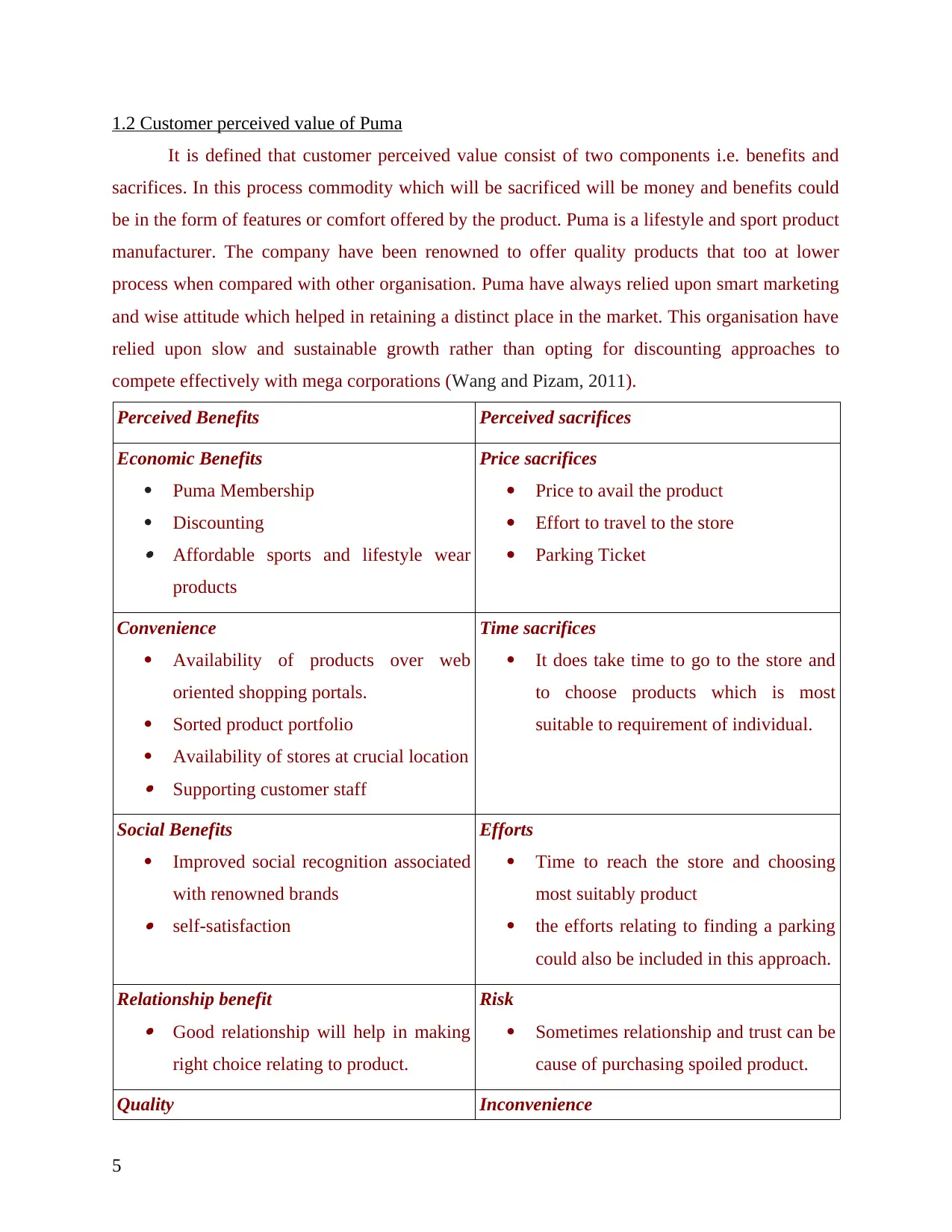
1.2 Customer perceived value of Puma
It is defined that customer perceived value consist of two components i.e. benefits and
sacrifices. In this process commodity which will be sacrificed will be money and benefits could
be in the form of features or comfort offered by the product. Puma is a lifestyle and sport product
manufacturer. The company have been renowned to offer quality products that too at lower
process when compared with other organisation. Puma have always relied upon smart marketing
and wise attitude which helped in retaining a distinct place in the market. This organisation have
relied upon slow and sustainable growth rather than opting for discounting approaches to
compete effectively with mega corporations (Wang and Pizam, 2011).
Perceived Benefits Perceived sacrifices
Economic Benefits
Puma Membership
Discounting Affordable sports and lifestyle wear
products
Price sacrifices
Price to avail the product
Effort to travel to the store
Parking Ticket
Convenience
Availability of products over web
oriented shopping portals.
Sorted product portfolio
Availability of stores at crucial location Supporting customer staff
Time sacrifices
It does take time to go to the store and
to choose products which is most
suitable to requirement of individual.
Social Benefits
Improved social recognition associated
with renowned brands self-satisfaction
Efforts
Time to reach the store and choosing
most suitably product
the efforts relating to finding a parking
could also be included in this approach.
Relationship benefit Good relationship will help in making
right choice relating to product.
Risk
Sometimes relationship and trust can be
cause of purchasing spoiled product.
Quality Inconvenience
5
It is defined that customer perceived value consist of two components i.e. benefits and
sacrifices. In this process commodity which will be sacrificed will be money and benefits could
be in the form of features or comfort offered by the product. Puma is a lifestyle and sport product
manufacturer. The company have been renowned to offer quality products that too at lower
process when compared with other organisation. Puma have always relied upon smart marketing
and wise attitude which helped in retaining a distinct place in the market. This organisation have
relied upon slow and sustainable growth rather than opting for discounting approaches to
compete effectively with mega corporations (Wang and Pizam, 2011).
Perceived Benefits Perceived sacrifices
Economic Benefits
Puma Membership
Discounting Affordable sports and lifestyle wear
products
Price sacrifices
Price to avail the product
Effort to travel to the store
Parking Ticket
Convenience
Availability of products over web
oriented shopping portals.
Sorted product portfolio
Availability of stores at crucial location Supporting customer staff
Time sacrifices
It does take time to go to the store and
to choose products which is most
suitable to requirement of individual.
Social Benefits
Improved social recognition associated
with renowned brands self-satisfaction
Efforts
Time to reach the store and choosing
most suitably product
the efforts relating to finding a parking
could also be included in this approach.
Relationship benefit Good relationship will help in making
right choice relating to product.
Risk
Sometimes relationship and trust can be
cause of purchasing spoiled product.
Quality Inconvenience
5

Quality matches international
benchmarks products are durable and provide value
to consumer
Staff at the store may be distracted or
disinterested
Breakdown in machinery
UN-Accessibility of different payment
modes.
2.0 Suitable models to identify the customer perceived value for the customers
Puma is known for selling high quality product but at the same time their products are
very expensive. Customer prefer to buy shoes and other accessories from this organisation but
high price, low availability etc. are some factor which restrict them from buying Puma's
products. Getting high quality is a ''benefit'' but paying more money in a ''sacrifice''. Below are
perceived benefits and sacrifices:
Benefits
Economic benefits – Getting fine quality of product at affordable price is one area which
Puma never ignores. Customer are ready to pay more money if they feel that they are getting
right value of the money which they are paying (Moutinho, 2011). Affordable products is
beneficial for buyers and company also.
Convenience/Accessibility – Puma always open their stores in prime location.
Accessibility to stores motivate customer to visit their outlets and buy something from their.
They have fixed time of opening and closing their stores so customer do not get any kind of
confusion. Online sale of products is also helping both buyer and company is removing the
problems regarding accessibility.
Social benefits – Puma has a high brand value they are considered as one of the most
famous and successful brand of shoes and other accessories. People who has high self esteem
and only prefer to buy quality products then Puma is among first name which come in their mind
(Michaelidou, Siamagka and Christodoulides, 2011). If customer will buy products of Puma then
this will send a message a soeity that buyer is rich and successful.
Perceived sacrifices
6
benchmarks products are durable and provide value
to consumer
Staff at the store may be distracted or
disinterested
Breakdown in machinery
UN-Accessibility of different payment
modes.
2.0 Suitable models to identify the customer perceived value for the customers
Puma is known for selling high quality product but at the same time their products are
very expensive. Customer prefer to buy shoes and other accessories from this organisation but
high price, low availability etc. are some factor which restrict them from buying Puma's
products. Getting high quality is a ''benefit'' but paying more money in a ''sacrifice''. Below are
perceived benefits and sacrifices:
Benefits
Economic benefits – Getting fine quality of product at affordable price is one area which
Puma never ignores. Customer are ready to pay more money if they feel that they are getting
right value of the money which they are paying (Moutinho, 2011). Affordable products is
beneficial for buyers and company also.
Convenience/Accessibility – Puma always open their stores in prime location.
Accessibility to stores motivate customer to visit their outlets and buy something from their.
They have fixed time of opening and closing their stores so customer do not get any kind of
confusion. Online sale of products is also helping both buyer and company is removing the
problems regarding accessibility.
Social benefits – Puma has a high brand value they are considered as one of the most
famous and successful brand of shoes and other accessories. People who has high self esteem
and only prefer to buy quality products then Puma is among first name which come in their mind
(Michaelidou, Siamagka and Christodoulides, 2011). If customer will buy products of Puma then
this will send a message a soeity that buyer is rich and successful.
Perceived sacrifices
6
⊘ This is a preview!⊘
Do you want full access?
Subscribe today to unlock all pages.

Trusted by 1+ million students worldwide
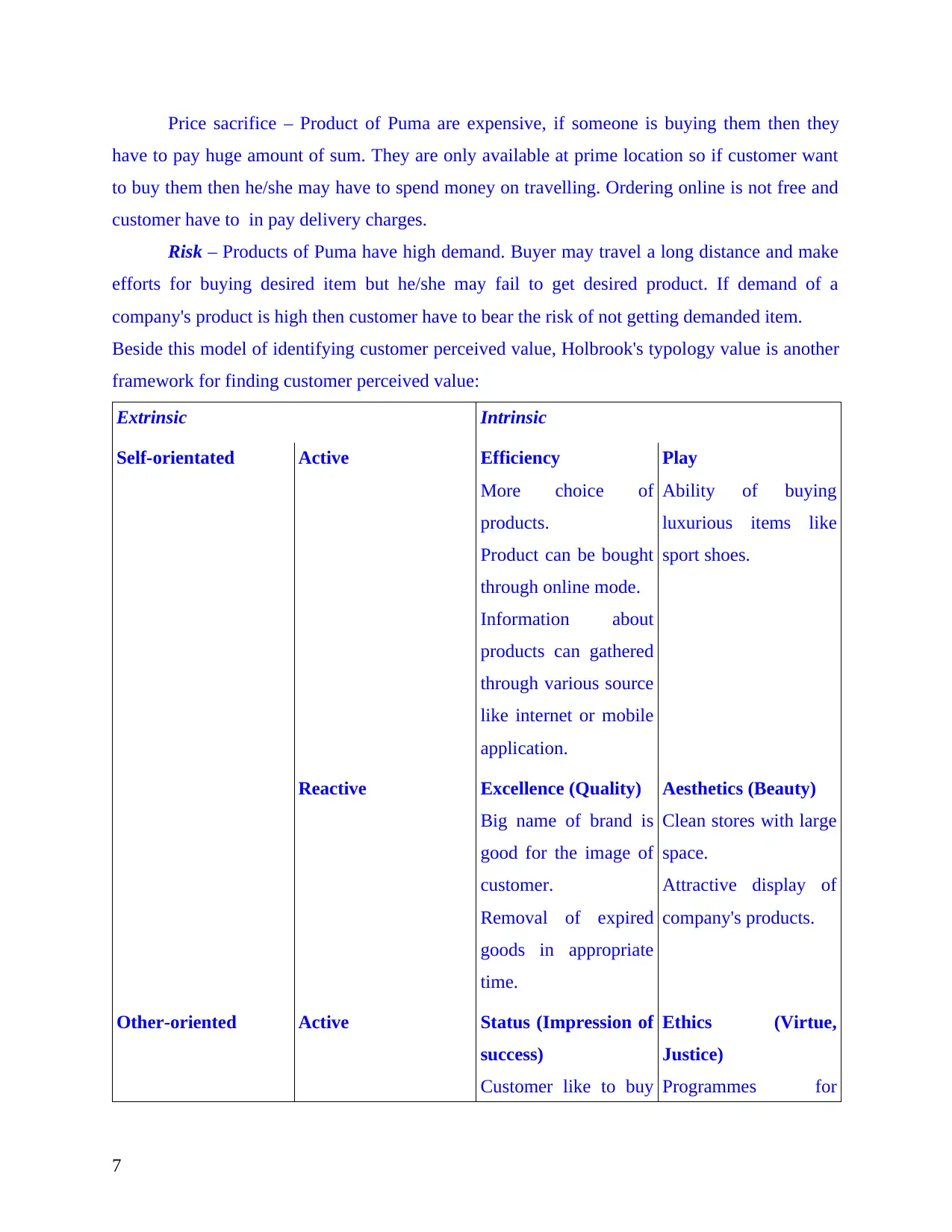
Price sacrifice – Product of Puma are expensive, if someone is buying them then they
have to pay huge amount of sum. They are only available at prime location so if customer want
to buy them then he/she may have to spend money on travelling. Ordering online is not free and
customer have to in pay delivery charges.
Risk – Products of Puma have high demand. Buyer may travel a long distance and make
efforts for buying desired item but he/she may fail to get desired product. If demand of a
company's product is high then customer have to bear the risk of not getting demanded item.
Beside this model of identifying customer perceived value, Holbrook's typology value is another
framework for finding customer perceived value:
Extrinsic Intrinsic
Self-orientated Active Efficiency
More choice of
products.
Product can be bought
through online mode.
Information about
products can gathered
through various source
like internet or mobile
application.
Play
Ability of buying
luxurious items like
sport shoes.
Reactive Excellence (Quality)
Big name of brand is
good for the image of
customer.
Removal of expired
goods in appropriate
time.
Aesthetics (Beauty)
Clean stores with large
space.
Attractive display of
company's products.
Other-oriented Active Status (Impression of
success)
Customer like to buy
Ethics (Virtue,
Justice)
Programmes for
7
have to pay huge amount of sum. They are only available at prime location so if customer want
to buy them then he/she may have to spend money on travelling. Ordering online is not free and
customer have to in pay delivery charges.
Risk – Products of Puma have high demand. Buyer may travel a long distance and make
efforts for buying desired item but he/she may fail to get desired product. If demand of a
company's product is high then customer have to bear the risk of not getting demanded item.
Beside this model of identifying customer perceived value, Holbrook's typology value is another
framework for finding customer perceived value:
Extrinsic Intrinsic
Self-orientated Active Efficiency
More choice of
products.
Product can be bought
through online mode.
Information about
products can gathered
through various source
like internet or mobile
application.
Play
Ability of buying
luxurious items like
sport shoes.
Reactive Excellence (Quality)
Big name of brand is
good for the image of
customer.
Removal of expired
goods in appropriate
time.
Aesthetics (Beauty)
Clean stores with large
space.
Attractive display of
company's products.
Other-oriented Active Status (Impression of
success)
Customer like to buy
Ethics (Virtue,
Justice)
Programmes for
7
Paraphrase This Document
Need a fresh take? Get an instant paraphrase of this document with our AI Paraphraser
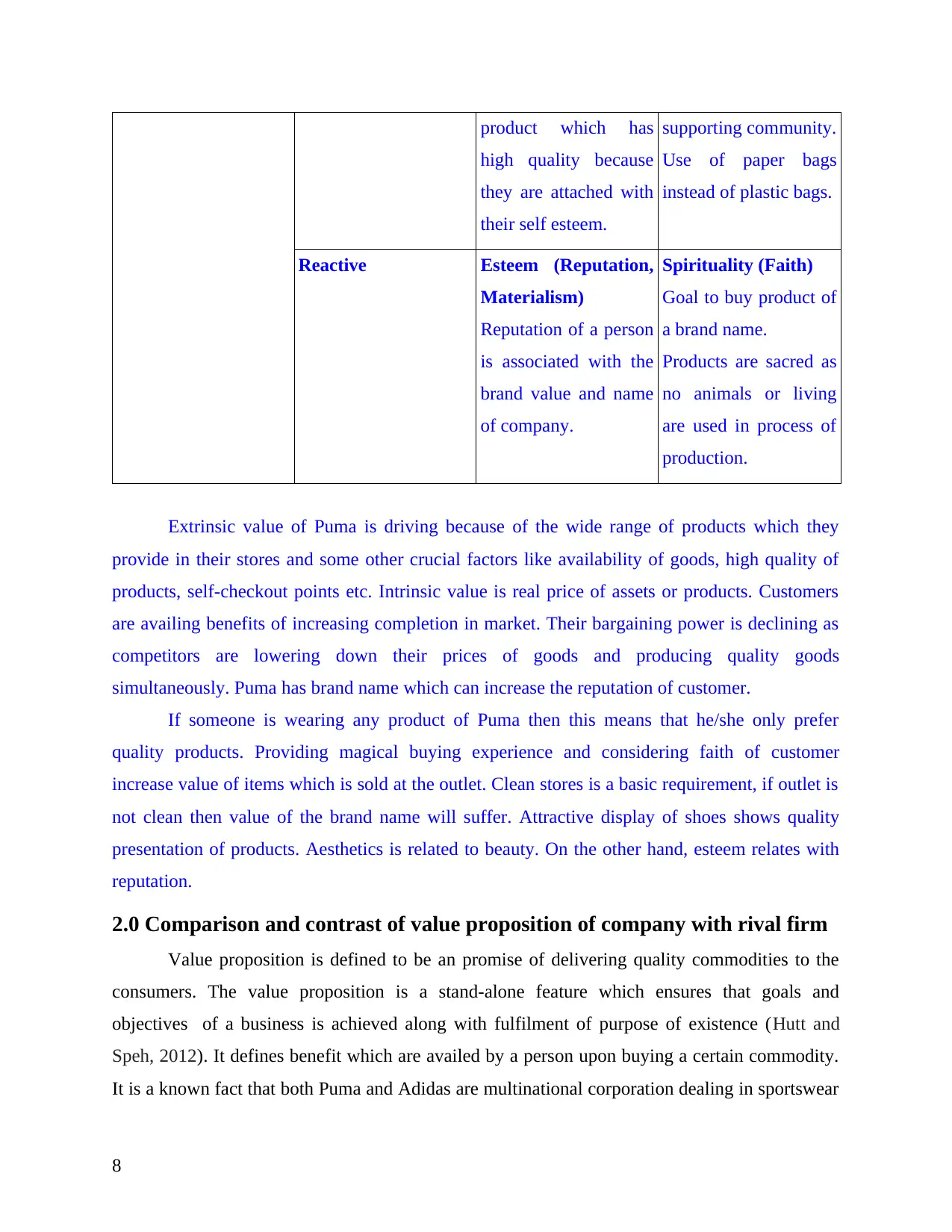
product which has
high quality because
they are attached with
their self esteem.
supporting community.
Use of paper bags
instead of plastic bags.
Reactive Esteem (Reputation,
Materialism)
Reputation of a person
is associated with the
brand value and name
of company.
Spirituality (Faith)
Goal to buy product of
a brand name.
Products are sacred as
no animals or living
are used in process of
production.
Extrinsic value of Puma is driving because of the wide range of products which they
provide in their stores and some other crucial factors like availability of goods, high quality of
products, self-checkout points etc. Intrinsic value is real price of assets or products. Customers
are availing benefits of increasing completion in market. Their bargaining power is declining as
competitors are lowering down their prices of goods and producing quality goods
simultaneously. Puma has brand name which can increase the reputation of customer.
If someone is wearing any product of Puma then this means that he/she only prefer
quality products. Providing magical buying experience and considering faith of customer
increase value of items which is sold at the outlet. Clean stores is a basic requirement, if outlet is
not clean then value of the brand name will suffer. Attractive display of shoes shows quality
presentation of products. Aesthetics is related to beauty. On the other hand, esteem relates with
reputation.
2.0 Comparison and contrast of value proposition of company with rival firm
Value proposition is defined to be an promise of delivering quality commodities to the
consumers. The value proposition is a stand-alone feature which ensures that goals and
objectives of a business is achieved along with fulfilment of purpose of existence (Hutt and
Speh, 2012). It defines benefit which are availed by a person upon buying a certain commodity.
It is a known fact that both Puma and Adidas are multinational corporation dealing in sportswear
8
high quality because
they are attached with
their self esteem.
supporting community.
Use of paper bags
instead of plastic bags.
Reactive Esteem (Reputation,
Materialism)
Reputation of a person
is associated with the
brand value and name
of company.
Spirituality (Faith)
Goal to buy product of
a brand name.
Products are sacred as
no animals or living
are used in process of
production.
Extrinsic value of Puma is driving because of the wide range of products which they
provide in their stores and some other crucial factors like availability of goods, high quality of
products, self-checkout points etc. Intrinsic value is real price of assets or products. Customers
are availing benefits of increasing completion in market. Their bargaining power is declining as
competitors are lowering down their prices of goods and producing quality goods
simultaneously. Puma has brand name which can increase the reputation of customer.
If someone is wearing any product of Puma then this means that he/she only prefer
quality products. Providing magical buying experience and considering faith of customer
increase value of items which is sold at the outlet. Clean stores is a basic requirement, if outlet is
not clean then value of the brand name will suffer. Attractive display of shoes shows quality
presentation of products. Aesthetics is related to beauty. On the other hand, esteem relates with
reputation.
2.0 Comparison and contrast of value proposition of company with rival firm
Value proposition is defined to be an promise of delivering quality commodities to the
consumers. The value proposition is a stand-alone feature which ensures that goals and
objectives of a business is achieved along with fulfilment of purpose of existence (Hutt and
Speh, 2012). It defines benefit which are availed by a person upon buying a certain commodity.
It is a known fact that both Puma and Adidas are multinational corporation dealing in sportswear
8

segment. However Adidas possess an superior business position in the market. Puma is a brand
which is aiming to integrate sports and lifestyle through its offerings whereas Adidas is focused
on innovation which assists in improving athletic performance. The results which have been
derived from Monroe and Holbrook analysis will be further utilised to study value proposition
which has been offered by Puma.
All the efforts of Puma is emphasised on being a market leader in sports and lifestyle
wear segment. To achieve the stated position, it is extremely important to take into consideration
customer's needs and expectation so that value perception could be formulated. In such scenario
of intense competition it is important for business organisation to rely their operation on the
value proposition. Persona of the company relies on partnerships and co-branding with other
organisation such as Ferrari, Bugatti and other famous designers (Leonidou and Leonidou,
2011). The table below takes into consideration strategy and value positioning which has been
employed by both the organisations.
Customer Value strategy and Positioning
Puma Adidas
Market, Mission and
value strategy
Mission: The mission of the
company is to be an creative
leader when it comes to sport
and lifestyle products and
accessories. This organisation
aims to fulfil its responsibility
towards a world to create a better
universe.
Value: The company relies on
being fair and honest when it
comes to serving target
consumer base.
Business strategy: the company
is relying upon its brand name
and presence in market for
purpose of excelling in
Mission: the mission statement for
the company strives to be a global
leader in the sports industry and
lifestyle. The efforts are derived into
strengthening the brand so that a
superior business position is
achieved.
Value: the value propositions which
are offered by the company are
innovation, customisation and brand
status.
Their is an heavy reliance upon the
innovation in this organisation and
that too in all the major sectors such
as athlete, manufacturing, experience
9
which is aiming to integrate sports and lifestyle through its offerings whereas Adidas is focused
on innovation which assists in improving athletic performance. The results which have been
derived from Monroe and Holbrook analysis will be further utilised to study value proposition
which has been offered by Puma.
All the efforts of Puma is emphasised on being a market leader in sports and lifestyle
wear segment. To achieve the stated position, it is extremely important to take into consideration
customer's needs and expectation so that value perception could be formulated. In such scenario
of intense competition it is important for business organisation to rely their operation on the
value proposition. Persona of the company relies on partnerships and co-branding with other
organisation such as Ferrari, Bugatti and other famous designers (Leonidou and Leonidou,
2011). The table below takes into consideration strategy and value positioning which has been
employed by both the organisations.
Customer Value strategy and Positioning
Puma Adidas
Market, Mission and
value strategy
Mission: The mission of the
company is to be an creative
leader when it comes to sport
and lifestyle products and
accessories. This organisation
aims to fulfil its responsibility
towards a world to create a better
universe.
Value: The company relies on
being fair and honest when it
comes to serving target
consumer base.
Business strategy: the company
is relying upon its brand name
and presence in market for
purpose of excelling in
Mission: the mission statement for
the company strives to be a global
leader in the sports industry and
lifestyle. The efforts are derived into
strengthening the brand so that a
superior business position is
achieved.
Value: the value propositions which
are offered by the company are
innovation, customisation and brand
status.
Their is an heavy reliance upon the
innovation in this organisation and
that too in all the major sectors such
as athlete, manufacturing, experience
9
⊘ This is a preview!⊘
Do you want full access?
Subscribe today to unlock all pages.

Trusted by 1+ million students worldwide
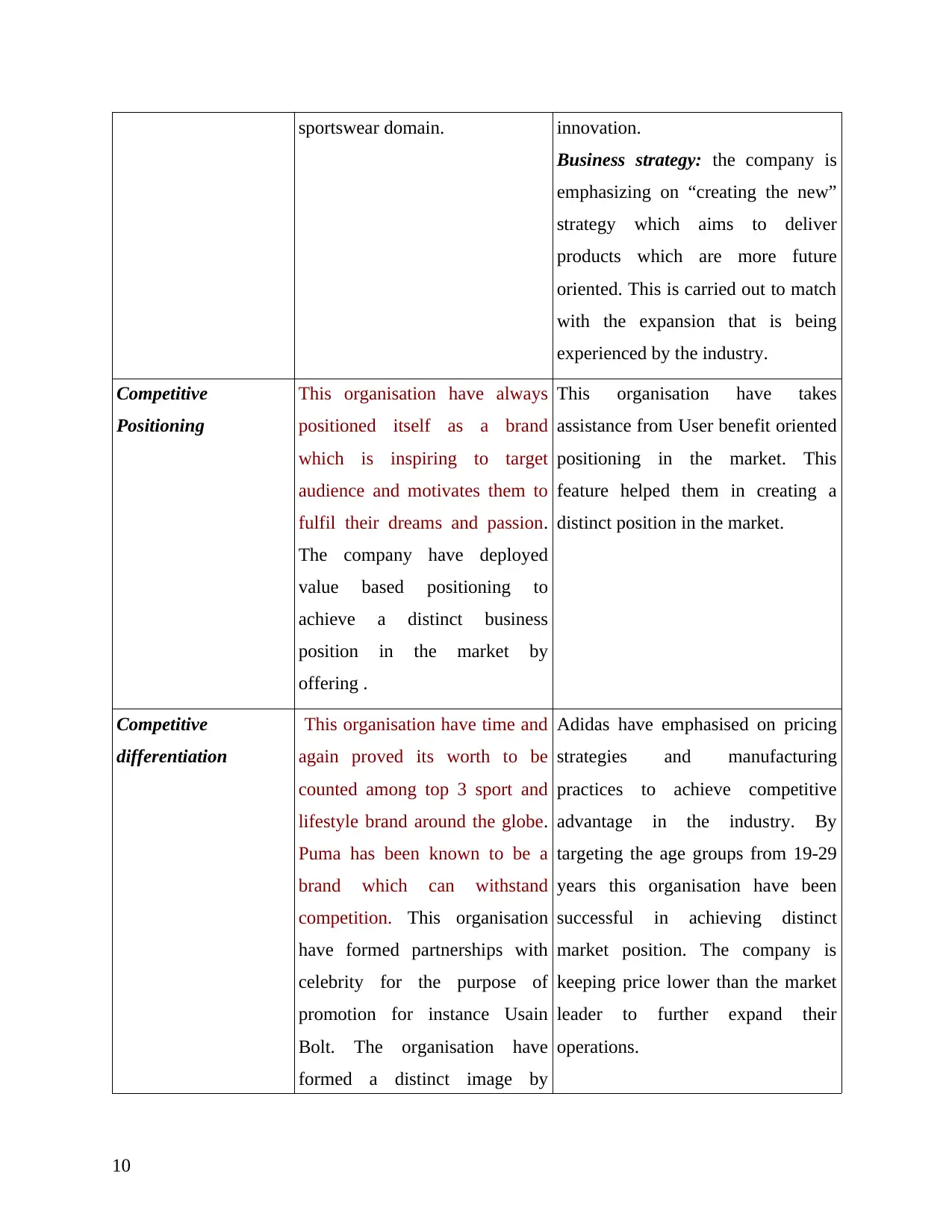
sportswear domain. innovation.
Business strategy: the company is
emphasizing on “creating the new”
strategy which aims to deliver
products which are more future
oriented. This is carried out to match
with the expansion that is being
experienced by the industry.
Competitive
Positioning
This organisation have always
positioned itself as a brand
which is inspiring to target
audience and motivates them to
fulfil their dreams and passion.
The company have deployed
value based positioning to
achieve a distinct business
position in the market by
offering .
This organisation have takes
assistance from User benefit oriented
positioning in the market. This
feature helped them in creating a
distinct position in the market.
Competitive
differentiation
This organisation have time and
again proved its worth to be
counted among top 3 sport and
lifestyle brand around the globe.
Puma has been known to be a
brand which can withstand
competition. This organisation
have formed partnerships with
celebrity for the purpose of
promotion for instance Usain
Bolt. The organisation have
formed a distinct image by
Adidas have emphasised on pricing
strategies and manufacturing
practices to achieve competitive
advantage in the industry. By
targeting the age groups from 19-29
years this organisation have been
successful in achieving distinct
market position. The company is
keeping price lower than the market
leader to further expand their
operations.
10
Business strategy: the company is
emphasizing on “creating the new”
strategy which aims to deliver
products which are more future
oriented. This is carried out to match
with the expansion that is being
experienced by the industry.
Competitive
Positioning
This organisation have always
positioned itself as a brand
which is inspiring to target
audience and motivates them to
fulfil their dreams and passion.
The company have deployed
value based positioning to
achieve a distinct business
position in the market by
offering .
This organisation have takes
assistance from User benefit oriented
positioning in the market. This
feature helped them in creating a
distinct position in the market.
Competitive
differentiation
This organisation have time and
again proved its worth to be
counted among top 3 sport and
lifestyle brand around the globe.
Puma has been known to be a
brand which can withstand
competition. This organisation
have formed partnerships with
celebrity for the purpose of
promotion for instance Usain
Bolt. The organisation have
formed a distinct image by
Adidas have emphasised on pricing
strategies and manufacturing
practices to achieve competitive
advantage in the industry. By
targeting the age groups from 19-29
years this organisation have been
successful in achieving distinct
market position. The company is
keeping price lower than the market
leader to further expand their
operations.
10
Paraphrase This Document
Need a fresh take? Get an instant paraphrase of this document with our AI Paraphraser

focusing on innovation.
Marketing assets The company is known to be
renowned brand in the market
and diversified portfolio helped
in achieving revenue of 4.1
billion euros.
The company have takes assistance
from push marketing strategy to
enlarge its operations further. Three
stripes of the company are
recognised all over the world.
The above factors determine the distinction which is carried out between Puma and
Adidas. The areas which are emphasised are strategy relating to differentiation and positioning
which are adopted by cited organisation (Michaelidou, Siamagka and Christodoulides, 2011).
Through comparing various components, rating between Adidas and Puma's value proposition
can evaluate. Mission of Adidas is to develop each and every athlete performance by innovation.
In order to compete traditional competitor's value proposition, Adidas has aimed their
communication of brand in three distinct sector i.e. sport style, sport heritage and sport
performance. Both of these organisation is delivering their services for specific i.e. sports and
lifestyle segment. Adidas and Puma both majorly spend their revenues and other efforts
interacting to the certain sport segments.
Competitive Positioning: Puma has placed itself as a major lifestyle and sports wear
manufacture who is known to deliver quality products and services at comparatively lower
prices. On the other hand, Adidas have been also keeping market prices lower than leader and
compete effectively in the market. The brand is known to be more innovative and sports oriented
and often opted by people who are unable to afford costly goods from Nike.
11
Marketing assets The company is known to be
renowned brand in the market
and diversified portfolio helped
in achieving revenue of 4.1
billion euros.
The company have takes assistance
from push marketing strategy to
enlarge its operations further. Three
stripes of the company are
recognised all over the world.
The above factors determine the distinction which is carried out between Puma and
Adidas. The areas which are emphasised are strategy relating to differentiation and positioning
which are adopted by cited organisation (Michaelidou, Siamagka and Christodoulides, 2011).
Through comparing various components, rating between Adidas and Puma's value proposition
can evaluate. Mission of Adidas is to develop each and every athlete performance by innovation.
In order to compete traditional competitor's value proposition, Adidas has aimed their
communication of brand in three distinct sector i.e. sport style, sport heritage and sport
performance. Both of these organisation is delivering their services for specific i.e. sports and
lifestyle segment. Adidas and Puma both majorly spend their revenues and other efforts
interacting to the certain sport segments.
Competitive Positioning: Puma has placed itself as a major lifestyle and sports wear
manufacture who is known to deliver quality products and services at comparatively lower
prices. On the other hand, Adidas have been also keeping market prices lower than leader and
compete effectively in the market. The brand is known to be more innovative and sports oriented
and often opted by people who are unable to afford costly goods from Nike.
11

(Source: Positioning Map, 2017)
It can be identified from the above graphical record that both Puma and Adidas comes
under segment of high performance and high priced goods for consumers. In comparison to
Puma, products which are being offered are priced slightly higher but lesser than Nike so that
customers feel that they are being provided with value goods and services and at the same time
maintaining their profitability as well. Therefore it is being perceived that Puma is offering
similar quality of products at a cheaper rate which attracts customers.
Competitive Differentiation: Puma have been able to successfully able to differentiated
its products from rivals as an amalgamation of sports and lifestyle brand. The partnerships with
sports celebrity and film-stars have emerged as an distinct marketing strategy (Hutt and Speh,
2012). Whereas upon comparison Adidas has emphasised on sport brand. The marketing tactics
and efforts of this brand have been perceived distinctly when compared with rival organisations.
Marketing Assets: The marketing efforts of Puma are renowned and marks strong
presence in the market. The association with sports stars and marketing tools employed have
been root cause of growth which is received by the company. On the other hand, Adidas is
comparatively less active when it comes to marketing activities.
3.0 Benchmarking and value proposition
It can identified from above analysis is that both stated organisation deliver quality
sportswear and equipments. However there are distinct approaches which are undertaken by both
organisation so that their products and services are perceived as different. Puma tend to focus
12
Illustration 1: Positioning Map
It can be identified from the above graphical record that both Puma and Adidas comes
under segment of high performance and high priced goods for consumers. In comparison to
Puma, products which are being offered are priced slightly higher but lesser than Nike so that
customers feel that they are being provided with value goods and services and at the same time
maintaining their profitability as well. Therefore it is being perceived that Puma is offering
similar quality of products at a cheaper rate which attracts customers.
Competitive Differentiation: Puma have been able to successfully able to differentiated
its products from rivals as an amalgamation of sports and lifestyle brand. The partnerships with
sports celebrity and film-stars have emerged as an distinct marketing strategy (Hutt and Speh,
2012). Whereas upon comparison Adidas has emphasised on sport brand. The marketing tactics
and efforts of this brand have been perceived distinctly when compared with rival organisations.
Marketing Assets: The marketing efforts of Puma are renowned and marks strong
presence in the market. The association with sports stars and marketing tools employed have
been root cause of growth which is received by the company. On the other hand, Adidas is
comparatively less active when it comes to marketing activities.
3.0 Benchmarking and value proposition
It can identified from above analysis is that both stated organisation deliver quality
sportswear and equipments. However there are distinct approaches which are undertaken by both
organisation so that their products and services are perceived as different. Puma tend to focus
12
Illustration 1: Positioning Map
⊘ This is a preview!⊘
Do you want full access?
Subscribe today to unlock all pages.

Trusted by 1+ million students worldwide
1 out of 20
Your All-in-One AI-Powered Toolkit for Academic Success.
+13062052269
info@desklib.com
Available 24*7 on WhatsApp / Email
![[object Object]](/_next/static/media/star-bottom.7253800d.svg)
Unlock your academic potential
Copyright © 2020–2025 A2Z Services. All Rights Reserved. Developed and managed by ZUCOL.


